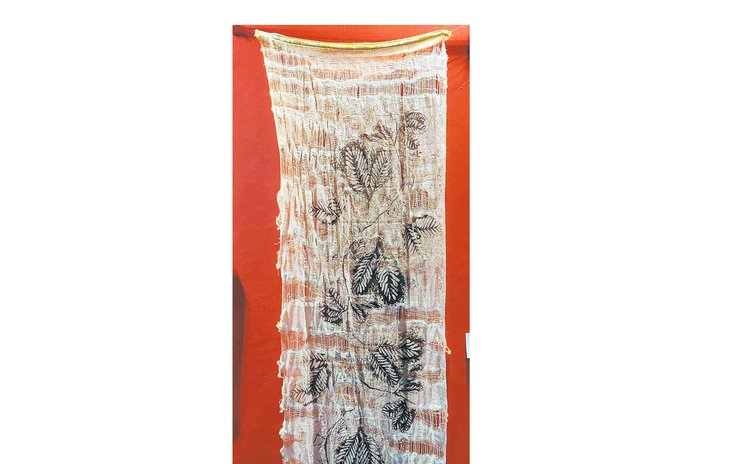Trois Piton in acrylics and Federation Drive in watercolours: Fun and adventure at the DOMFESTA Art Exhibition
By EMME

The DOMFESTA events had been going very well, I was told, and patrons for each of the occasions had great things to say. Oh really? I had thought to myself. I, too must get a slice of the festivities and observances. I can't let all of it just pass me by. So I consulted on what was left and decided to take in the Art Show at the old Mill.
I was told that several new artists were taking the opportunity to share their pieces. I had already missed the official opening. It would be just a moment for me. So fun and adventure, here I come.
Turning left, I entered the first level, and a series of pieces by Carol Sorhaindo caught my attention. I smiled. It was going to be good. I saw two depictions of the sensitive plant, the first a black and white piece simply called Sensitive Plant, Meze Mawi, which she described as a screen print on manipulated textiles. It was so vivid that I was tempted to touch it to see whether the leaves would close as they did when as children we sang, "Meze Mawi femen la pot ou, polis ka vini pon'w."
The second depiction of the plant was also exciting, appearing against a bright red background, as a pink lace curtain with the sensitive plant placed on it in an intricate pattern. Lovely, I thought as I stared at the piece of work. Classy. A creative mind conceptualised and created this. It was another screen print.
Carol also depicted unexpected details in her paintings. She would paint a series of bricks with plants growing in between. Ruins? No, more an undaunted bit of a building that supports a plant eager to give inspiration, purpose, healing to a woman, let us say, willing and able to receive... I lingered a while and then moved on.
Aaron Hamilton did not disappoint with his offerings. I recognised his strong and confident style as he presented Trois Piton in acrylics and Federation Drive in watercolours. There were depictions of faces and ladies in streets by St. Clair. I thought I recognised the people. Real talent was on display here. I was pleased to see a few from a seven-year-old who dabbed her hands in bright paint and arranged the blots on paper. The title she chose was Turtles. She exercised her freedom of self-expression and shared a determined thought in the process. I see promise.
There was much to see that highlighted cultural expressions. I caught sight of a jingping band as a couple danced while Hilary St. Clair shared an oil on canvas one he called Coffee Time. I saw the slices of bread before I saw the kettle-like pot. They were placed on a plate at table with a napkin that invited me to sit. Everything was set for me. Carol had some wall-length pieces incorporating various plants and other elements within her environment. Indeed I was not cheated.
The vibrations on the lower level of the Exhibition were like an encounter of zones. Some were carnivalesque; others depicted swirls and tunnels with persons in mid-travel from one end to the other. The works, on a whole, were like Alice in Wonderland. There was delightful use of colour, surreal motifs, human forms, foresty themes, rough seas and coconut palms.
On my way out, I paused for two things. I sent a wish to Dave Wilson, whose interesting piece had ushered me in, and I looked back at a painting where the artist had married an image of himself with one of Alwin Bully and the National Flag. I had paid my respects.




